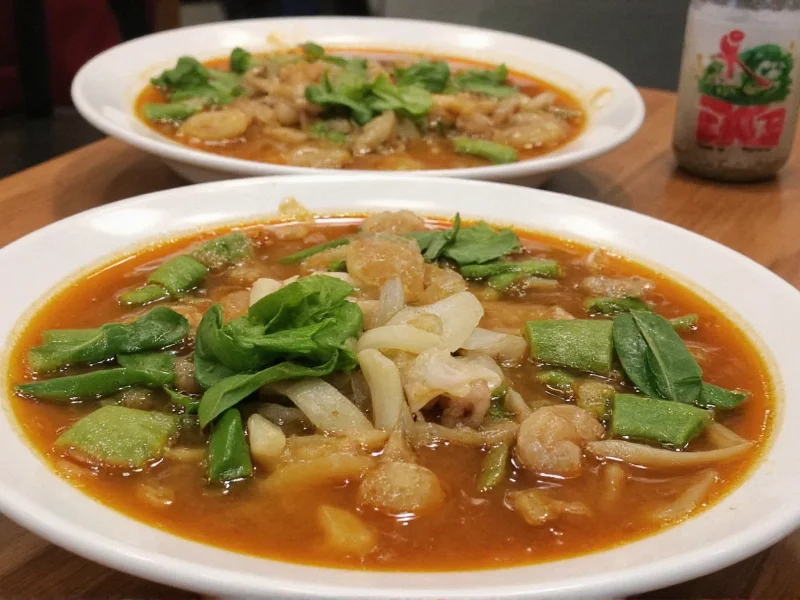Understanding these two iconic Vietnamese dishes requires exploring their historical roots, preparation techniques, and cultural contexts. While both originated in Vietnam, they serve different purposes in Vietnamese cuisine and daily life. Pho functions as a nourishing meal often consumed for breakfast, while banh mi serves as a convenient handheld lunch option.
The Essence of Authentic Pho
Pho's complexity begins with its broth, which requires meticulous preparation. Traditional pho broth simmers for 6-12 hours using beef or chicken bones, charred onions and ginger, and a blend of spices including star anise, cinnamon, cloves, and cardamom. This slow process extracts collagen and marrow, creating a rich, clear broth with deep umami flavor.
Rice noodles (bánh phở) must be cooked separately and added to the bowl just before serving to maintain their texture. The protein component varies by region—Northern Vietnam favors rare beef slices (phở bò), while Southern versions often include brisket, flank, and meatballs. Fresh herbs like Thai basil, cilantro, and culantro accompany the dish, along with bean sprouts and lime wedges for customization.
| Regional Variation | Broth Characteristics | Common Toppings |
|---|---|---|
| Northern (Hanoi style) | Clear, subtle, less sweet | Rare beef, minimal herbs |
| Southern (Saigon style) | Sweeter, more robust | Brisket, meatballs, abundant herbs |
| Central Vietnam | Bolder, spicier | Seafood options, chili peppers |
Decoding the Banh Mi Experience
Banh mi represents Vietnam's culinary adaptation of French colonial influence. The foundation is a light, airy baguette with a crisp crust—achieved through a unique rice flour and wheat flour blend. Traditional fillings combine Vietnamese and French elements: pâté, mayonnaise, various meats (like grilled pork or lemongrass chicken), and the essential pickled daikon and carrots (đồ chua).
The magic of banh mi lies in its balance of textures and flavors—crispy bread, tender meat, crunchy vegetables, and the interplay of savory, sweet, sour, and spicy elements. Regional variations exist: Northern versions tend to be simpler with fewer ingredients, while Southern banh mi often features more fillings and bolder flavors.
Comparing Culinary Roles and Cultural Significance
While both dishes are Vietnamese staples, they serve different functions in daily life. Pho traditionally functions as a complete meal, often eaten for breakfast in Vietnam. The ritual of preparing and consuming pho involves multiple steps—adding herbs, squeezing lime, and adjusting flavors to personal preference.
Banh mi serves as Vietnam's answer to fast food—portable, affordable, and satisfying. Street vendors typically assemble banh mi to order, slicing the baguette, spreading pâté and mayonnaise, adding protein, and finishing with pickled vegetables and chili. This sandwich has gained international popularity due to its convenient format and complex flavor profile.
Authentic Preparation Techniques
Creating genuine pho requires attention to detail. The broth must remain clear, achieved by skimming impurities during simmering and avoiding boiling once spices are added. Noodles should be cooked al dente and rinsed in cold water to prevent sticking. Meat should be thinly sliced against the grain for optimal tenderness.
For banh mi, the bread quality is paramount—it should crack when squeezed but remain flexible enough to bite through. The pickled vegetables require precise vinegar-to-sugar ratios and sufficient marinating time. Proper assembly sequence matters: pâté and mayonnaise first to create a moisture barrier, followed by meat, vegetables, and herbs.
Common Misconceptions Clarified
Many Western adaptations misrepresent these dishes. Authentic pho doesn't contain soy sauce or hoisin in the broth—these are optional condiments added at the table. Banh mi isn't simply a Vietnamese version of a sub sandwich; its specific bread texture and ingredient combinations create a unique culinary experience.
The term "souper pho" isn't traditional Vietnamese terminology—pho is inherently a soup dish. Some restaurants use "souper" as marketing language, but in authentic contexts, it's simply pho. Understanding these distinctions helps appreciate the dishes' cultural authenticity rather than commercialized versions.
Enjoying Pho and Banh Mi Authentically
To experience these dishes as intended, follow traditional consumption methods. For pho, add herbs and bean sprouts directly to the broth, squeeze lime for brightness, and use chopsticks with a spoon for proper eating technique. With banh mi, eat it immediately while the bread remains crisp, and don't press it—authentic banh mi isn't a pressed sandwich like a Cuban.
Pairing suggestions enhance the experience: pho traditionally accompanies Thai iced tea or fresh sugarcane juice, while banh mi pairs well with Vietnamese iced coffee. Understanding these combinations provides a more complete cultural experience beyond just the main dishes.
What's the difference between Northern and Southern pho?
Northern pho (Hanoi style) features a clearer, more subtle broth with less sugar and fewer herbs. It typically includes rare beef slices and minimal garnishes. Southern pho (Saigon style) has a sweeter, more robust broth with additional spices, often includes multiple meat cuts like brisket and meatballs, and comes with abundant fresh herbs and bean sprouts for customization.
Is banh mi always made with pork?
No, while pork-based fillings like grilled pork (thịt nướng) are popular, traditional banh mi offers various protein options including chicken, tofu, pâté, and even seafood in coastal regions. The essential elements are the baguette, pâté or mayonnaise, pickled vegetables, and chili peppers—proteins can vary based on preference and regional availability.
Can pho be considered healthy?
Traditional pho can be nutritious when prepared authentically. The long-simmered bone broth provides collagen and minerals, while fresh herbs offer antioxidants. However, sodium content can be high, and portion sizes matter—authentic Vietnamese servings are typically smaller than Western adaptations. Choosing lean meats and loading up on herbs and vegetables increases nutritional value while maintaining authenticity.
Why is the bread for banh mi different from regular baguettes?
Banh mi bread uses a unique blend of wheat and rice flour, creating a lighter, airier texture with a crispier crust that remains flexible. This special formulation prevents sogginess when filled with moist ingredients while providing the necessary crunch. Traditional French baguettes would become too soggy or too hard when used for banh mi fillings.











 浙公网安备
33010002000092号
浙公网安备
33010002000092号 浙B2-20120091-4
浙B2-20120091-4